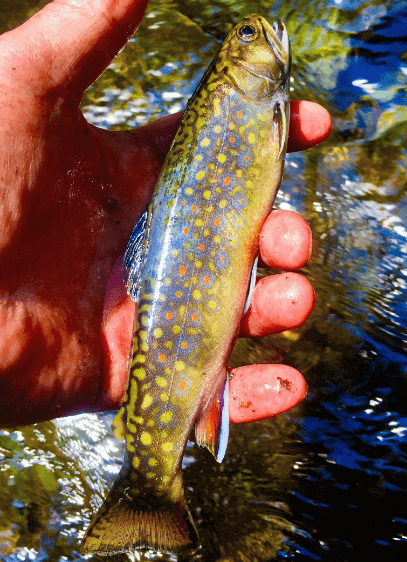The intertwined depths of art and fly fishing

The intrinsic values of fly fishing and fine art are intertwined to depths unimaginable to the untrained eye. The rhythm of motion in a perfectly thrown cast and the fluid stroke of a brush. The arcing line of a weight-forward fly line and the loading of a well-structured rod blank imitates the weight of paint on the brush as the artist transfers the subtle nuances of color to the canvas. The ethereal colors of the brook trout’s blue halos surrounding the burnt orange spots are reminiscent of a summer sunset on a palette of bluish-purple sky.
It is no coincidence that the range of colors offer us proof of a Higher Power’s joy in creating scenes that draw awe and wonder from those of us lucky enough to still be walking on this earth.
My wife, Katie, who is a remarkable artist, spends her days capturing these salutary moments of bliss. It’s no wonder that she has a love of fly fishing. For those of us who are fortunate enough to be blessed with the ability to notice and revel in the beauty of a present moment, fly fishing and art are the essence of natural connection.
Sometimes I sit in the old worn leather chair in her studio and quietly watch her paintings evolve from thought, to spirit, to brush, to canvas. She is able to capture the essence of a feeling in the same way that holding a brook trout in my hand, as its colors sparkle in the sunshine, engages my deepest, most spiritual connection to our world.
As we stand in the gurgling stream near our house at sunset, casting colorful flies into the dark blue waters below the frothy white falls, I watch her work her Sage fly rod with the same precision and rhythm that she bestows upon her brush in the studio. The fly line forms a beautiful U-shaped arc behind her and builds its speed as it whips toward the pool. The fly, an elk hair caddis with a rust-colored thorax, reaches the apogee of the arc, then slows down to land gently just below the tail of the froth. The fly spins on the rippling water as if it were alive and begins to drift downstream toward the slower water at the bottom of the pool.
Katie is watching the imitation with the same focus and intensity that exemplifies her work in the studio. The timing is immaculate.
As the voracious fish breaks the surface of the stream, Katie is leaning into the cast to engage the trout the moment that it opens its mouth to swallow the deceiver. The instant that the mouth closes on the fly, Katie lifts her rod swiftly but not so much that it pulls the fly out of its mouth. The rod bends at the tip and throbs with passion as the dynamic tension of the artist and her subject commune in a moment of metaphysical connection. Two spirits interlocking in a world separated by only water and air.
The fish leaps into the air above, flashing its iridescent orange fins rimmed with white borders. For the moment, these two beings are enmeshed in the dance of life. The eternal struggle of mortality and all its wonder is represented by beauty and nature in this, the pinnacle of the present.
She coaxes the brook trout to her side, tenderly slipping the net under its flanks, and raises it above the water. Extracting the fly from the side of the brookie’s mouth with as little discomfort as possible, Katie raises the aquiline wonder to her face and offers it a blessing, then returns the creature to the comfort of its world. For a moment, the brookie seems to pause and reflect on what just happened. Was that an angel that just held its body and released it?
The next day, I rise early to go to work, and Katie is already in the studio working on a new painting.
I notice the blue halos around the burnt orange spots on the flank of the subject that is being created out of oil and canvas and smile.
Bradley Carleton is executive director of Sacred Hunter, a nonprofit that seeks to educate the public on the spiritual connection of man to nature.

